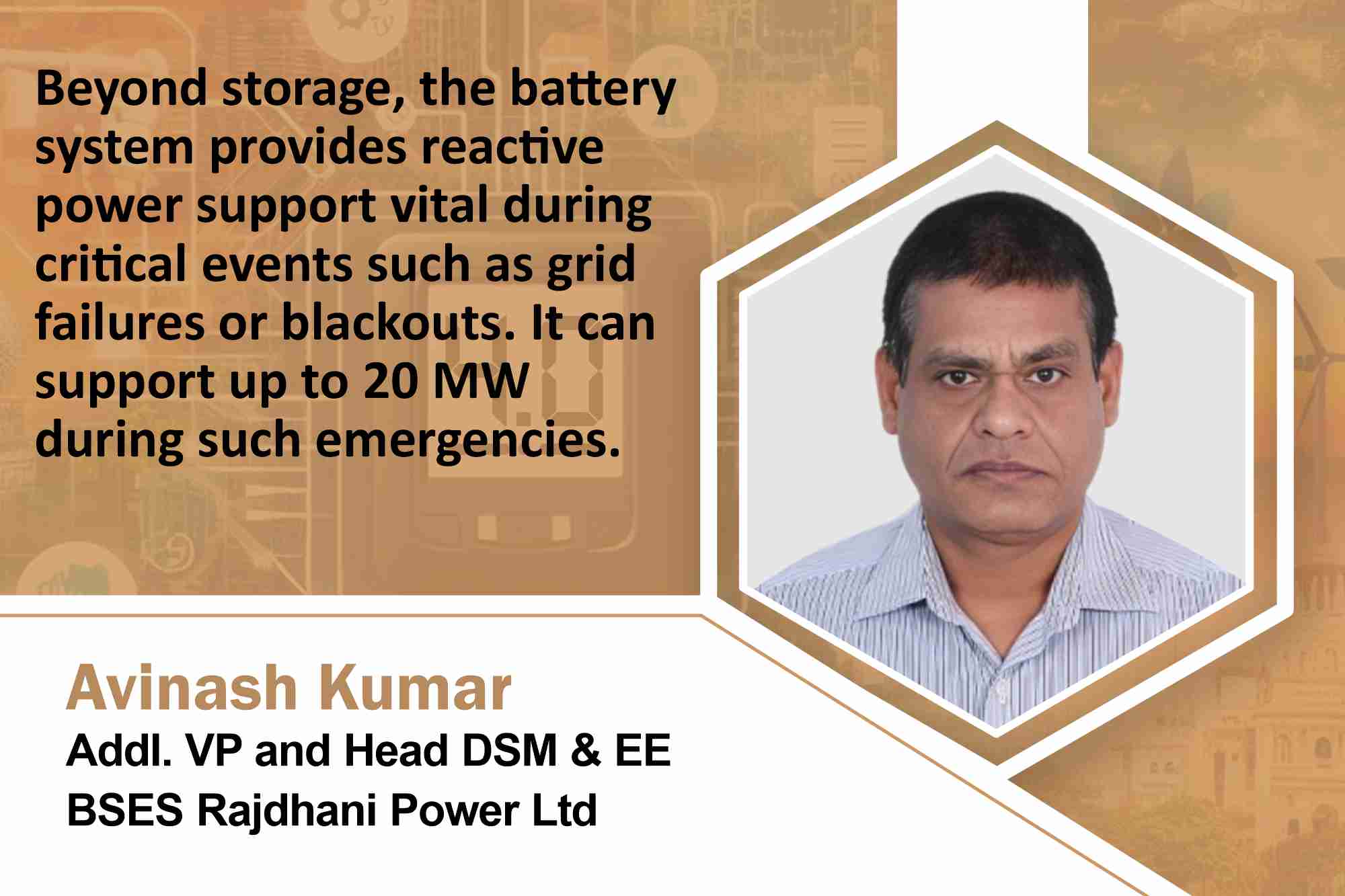BSES powering Delhi with battery storage, digital innovation
By Staff Report June 25, 2025 12:57 pm IST
By Staff Report June 25, 2025 12:57 pm IST

BSES Rajdhani Power Ltd has successfully installed South Asia’s first commercially deployed 40-megawatt-hour regulatory-approved project at the service station at the 11 kV voltage level.
BSES has redefined Delhi’s power landscape, reducing Aggregate Technical and Commercial (AT&C) losses from over 50 per cent to 6.61 per cent through digital innovation and smart metering. Serving 8.26 million consumers, BRPL and BYPL together ensure 24/7 reliable electricity, handling peak demands of 3,809 MW and 1,882 MW, respectively, with robust infrastructure and operational excellence.
Bridging Demand-Generation Mismatch with BESS
As India pushes toward its ambitious renewable energy target of 500 GW by 2030, storage technologies have become crucial. A core challenge faced by utilities like BSES is the misalignment between solar energy generation and peak electricity demand. Specifically, in BRPL, the load profile does not coincide with the solar regeneration curve. This mismatch underscores the need for demand-side management or robust energy storage solutions.
To address this, BSES Yamuna Power Limited has installed two significant Battery Energy Storage Systems (BESS) with capacities of 20 MW and 40 MW, respectively. These systems help store excess renewable energy and discharge it when demand spikes, ensuring grid stability. Funded by the Global Energy Alliance for People and Planet, the project is implemented on a BOOT (Build, Own, Operate, Transfer) model with a 12-year operating life and two charge-discharge cycles per day. This delivers an effective storage capacity of 20–40 megawatt-hours daily.
The technical architecture is meticulous. The energy storage system utilises 12 Power Conditioning Systems (PCSs), each rated at 2.5 MVA. The Direct Current (DC) output voltage of the system is approximately 1300 volts, while the Alternating Current (AC) output of the PCS is stepped up to 11 kV for integration into the distribution network.
Project Execution and Regulatory Milestones
BSES initiated techno-commercial modelling in May 2023. After receiving in-principle approval from the Central Electricity Regulatory Commission (CERC) in July, tenders were floated in September, followed by the submission of a petition in January 2024. The land for the project was handed over by June 2024. Subsequently, PCS factory acceptance tests were conducted in November, and the battery systems were commissioned by March 2025. The full project became operational between March 25 and April 2025.
Given its installation in a densely populated urban zone, safety protocols were paramount. Battery systems pose fire and failure risks through thermal runaway and electrical faults, as well as external propagation. To mitigate these, the system adheres to National Fire Protection Association (NFPA) guidelines and must pass UL and ICS certifications for safety and compliance.
Five Layers of Fire Protection
To ensure maximum safety, BSES has incorporated a five-layer fire protection architecture as mentioned below:Early Detection: The system can detect thermal runaway up to 15 minutes before it escalates.
Gas Detection and Ventilation: Carbon monoxide and sulphur dioxide gas detectors, along with temperature and smoke sensors, activate the ventilation system. If thresholds are breached, an aerosol fire extinguishing mechanism is deployed.
Cooling Systems: A chilled water-glycol system maintains the battery temperature below 50°C. If the system reaches 50°C, an alarm triggers, and an automated shutdown follows at 55°C.
Active Fire Prevention: Water spray systems provide additional suppression, and all containers and boundary panels have a two-hour fire rating. A minimum three-foot separation is maintained between the containers and panels.
Structural Protection: Fire-rated containers and spatial design prevent the propagation of fire, especially during cascading failures.
Strategic Advantages and Grid Support
Beyond storage, the battery system provides reactive power support vital during critical events such as grid failures or blackouts. It can support up to 20 MW during such emergencies. The National Load Dispatch Centre (NLDC) has successfully conducted both closed-loop and open-loop tests, enabling BSES to participate in the frequency regulation market. Through energy arbitrage charging during low-demand periods (stress down) and discharging during high-demand periods (stress up), the system contributes to overall grid flexibility and cost efficiency.
To sum up, BSES’s forward-thinking approach, from reducing AT&C losses to integrating advanced battery storage systems, highlights its pivotal role in the evolution of electricity in the capital city. With its blend of technological innovation, regulatory alignment and commitment to sustainability, BSES is not just keeping the lights on; it is lighting the path toward India’s Electricity 4.0 vision.
************************
We use cookies to personalize your experience. By continuing to visit this website you agree to our Terms & Conditions, Privacy Policy and Cookie Policy.